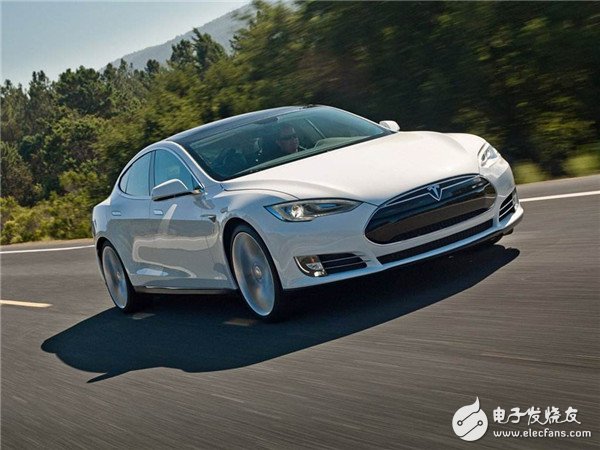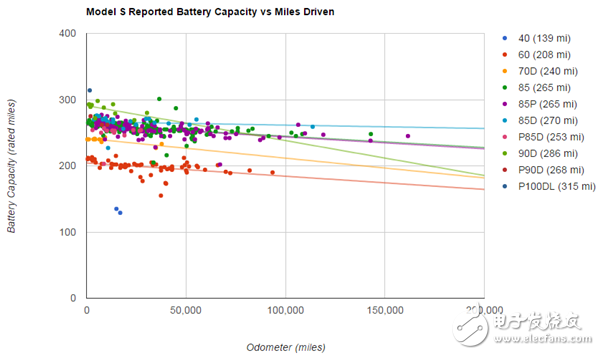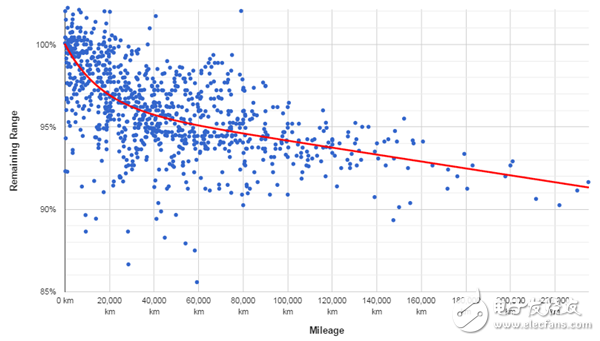Plug-in America collects data from Model S owners around the world in the form of a questionnaire that can be used to some extent to analyze the attenuation of Model S batteries. These data are vehicle meter display data collected from different owners in different regions.

Figure 1 is a plot of the rated range of the Model S's range and the odometer readings based on the collected data. In the figure, the Y-axis rated range data is read directly from the on-board instrument: after the car is fully charged, the car will display a rated range value indicating the number of miles the car can exercise after full charge, which is commonly used in the US and Canada. EPA mileage is indicated (in other countries, NEDC may be used). The capacity of the actual battery can not be measured here. Instead, after the charging is completed, the equivalent battery capacity is measured by the rated range displayed by the meter (because if the rated range displayed on the meter is lowered, the battery is also attenuated). The X-axis is the value displayed by the odometer of the car, which is the total number of miles accumulated by the vehicle. The different colors in the figure indicate the models of different Model S. Due to different configurations, driving conditions/habits, etc., the range will be different even under the same battery pack capacity. For example, there are 85, 85P, and P85D models with 85kWh batteries in the figure, and the corresponding range is different (some of them use software to limit the available energy in the BMS). The scatter point in the figure is the above two data (rated range vs. odometer) of different Years of different Model S vehicles collected, and the solid line is a trend line. It should be noted that some of the battery packs in these data have been replaced with battery packs or other components in the middle. In addition, these data points only reflect mileage data and do not reflect the usage time.

Figure 1 Model S driving range and odometer readings
Here we look at the vehicle with the highest odometer value (vehicle ID 291#), the odometer mileage is 161591mile, and the number of kilometers converted is ~260,000 kilometers, which is more than the 10year/150k required by the usual car. Mile life requirements. Here we look at the actual situation of the car: the owner is from Münnerstadt, Germany, and the model is the 2013 Model Year Model S Signature 85 Performance (P85D). As of 2016, the odometer reading is ~260,000 km (161,591 miles, the number of kilometers opened in three years, the owner is a heavy car user), 70% is highway, 30% is freeway, rated range is 245miles, three years The mileage attenuation during the period is approximately ~3% (with 253mile as the benchmark data for P85D). However, it should be noted that the car has changed the battery pack, one car charger and the four-drive drive unit within three years. The quality of the car is not very good.
Another Model S Signature 85 Performance of the 2012 Model Year with a vehicle ID of 130#, the car has not been replaced. As of July 2015, the odometer reading was 20,902,000 miles, or about 3.34, in more than three years. Ten thousand kilometers, 65% for highway, 45% for freeway, the car's rated range did not see attenuation.
Let's take a look at another Model S Signature 85 Performance car (vehicle ID 249#) for the same 2013 Model Year. As of March 28, 2017, the odometer showed 148,775 miles, or about 228,000 kilometers (of which 85% is highway, 15% is freeway), the rated range is about ~6% decay in 4 years. In the meantime, the battery pack has not been replaced, but the drive unit has been replaced four times.
However, there are also some car owners whose data shows a large attenuation. For example, the 2013 Model Year Model S Signature 85 Performance with a vehicle ID of 339#, as of July 2015, the odometer reading is 34.92 million miles, about 56,000 kilometers, the rated range is 228mile, the highway mileage is 10%, freeway The mileage accounted for 90%, and there were no replacement parts. The mileage reduction in the two years was about ~10%. Another 2014 Model Year with a Vehicle ID of 505#, as of July 2016, the rated range is 202mile, highway occupies 25%, and freeway occupies 75%. In the meantime, it has replaced a charger and a drive unit for about two years. The rated range is attenuated by about 20%, and this attenuation is more serious.

Figure 2 Relationship between the number of driving mileage and total mileage after Model S charging
The Tesla owners of the Dutch Dutch-Belgium Tesla Forum also made similar Model S data collection (Figure 2). Here the Y axis is the Remaining Range and the X axis is the Mileage. Compared with the data of Plug-in America, although the X/Y axis names are different, the meanings of the two are the same. Here the Mileage of the X-axis is also the vehicle odometer reading (Plug-in America is represented by the odometer), and the Y-axis remaining range is also the estimated driving range after the full charge (Plug-in America is expressed in the rated range). If you only look at the statistical trend curve, it seems that you can see that the Model S's driving range attenuation is very small. After driving 60,000 kilometers, the driving mileage attenuation is only 5%, 100,000 kilometers is about 6%, 200,000 kilometers. Attenuation is about 8%. Here we can only see the change data of the driving range, and can not see the change of the actual energy of the battery and the time corresponding to these parameters. Below we look at a few sets of other data (Table 1), you can see some of the other information behind Figure 2.
Table 1 US and Asia Pacific/Europe Model S user data

Bolier Manometer,Square Pressure Gauge,Square Manometer With Capillary,Square Manometer
ZHOUSHAN JIAERLING METER CO.,LTD , https://www.zsjrlmeter.com
![<?echo $_SERVER['SERVER_NAME'];?>](/template/twentyseventeen/skin/images/header.jpg)